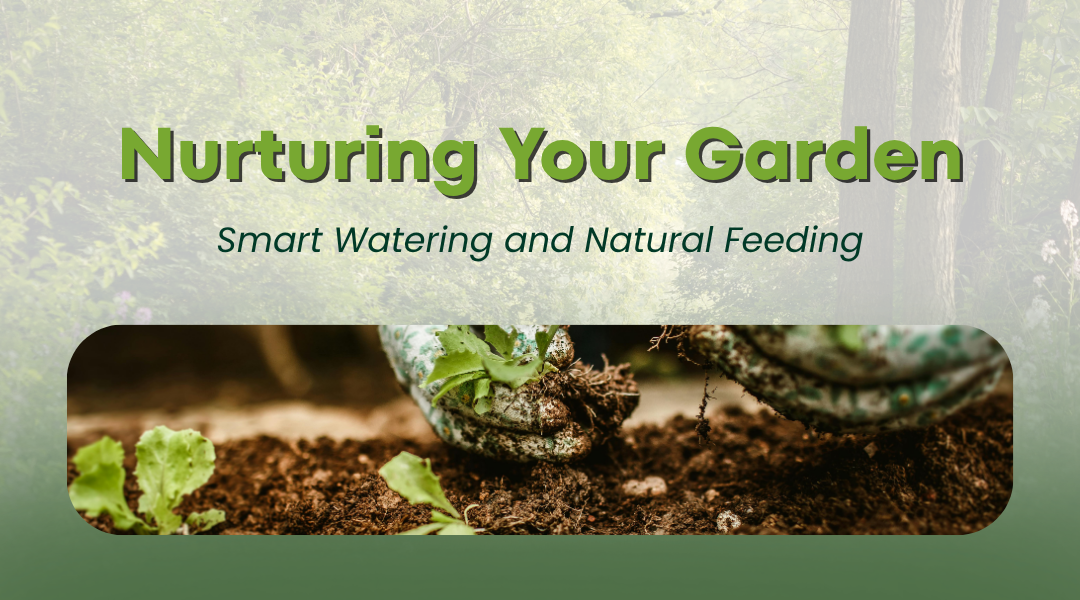Your garden is planted, seedlings are peeking through the soil, and the excitement of growth fills the air. At this stage, the two pillars that will determine your plants’ health are water and nutrients. In organic gardening, the aim is to support growth in harmony with nature—nourishing the soil and letting plants thrive without relying on synthetic chemicals. Here’s how to water intelligently and feed your plants naturally for a thriving garden.
Watering Your Garden: Striking the Right Balance
Water is more than just a drink for your plants—it’s their lifeline. It fuels photosynthesis, transports nutrients, and keeps leaves turgid and healthy. But both too little and too much can cause stress.
Principles of Effective Watering
- Deep and Infrequent Beats Shallow and Frequent: Watering deeply encourages roots to grow downward, creating drought-resilient plants. A daily light sprinkle leads to shallow roots that dry out quickly.
- Aim for Consistent Moisture: Soil should feel like a wrung-out sponge—damp, but not soggy. Avoid waterlogging, which can suffocate roots.
- Water the Base, Not the Leaves: Direct water to the soil around the roots. Wet leaves, especially at night, can promote fungal diseases such as powdery mildew or leaf spot.
- Morning is Best: Watering early gives plants time to absorb moisture before heat intensifies and allows leaves to dry during the day.
How Much and How Often
- The “Inch-a-Week” Rule: Many gardens need about one inch of water per week, whether from rain or irrigation. Adjust based on soil type, weather, and plant needs.
- Check the Soil: Dig 2–3 inches down. If it’s dry, water.
- Observe Your Plants: Wilting leaves signal thirst, but it’s better to water before severe stress occurs.
- Adjust by Conditions:
- Soil Type: Sandy soils drain quickly and need frequent watering; clay soils retain moisture longer.
- Weather: Hot, windy, or sunny days increase evaporation.
- Plant Stage: Young seedlings need regular moisture; established plants are more tolerant.
- Garden Type: Containers and raised beds dry out faster than in-ground plots.
Typical Frequencies: In-ground or raised beds may require watering 1–3 times weekly in dry periods. Containers might need daily attention during heatwaves.
Watering Methods
- Watering Can: Ideal for small gardens or containers; use a gentle “rose” head to avoid displacing soil.
- Hose with Wand: Allows precise watering at the base of plants. Choose a shower nozzle for even coverage.
- Soaker Hoses: Porous hoses that slowly release water directly to roots. Efficient and reduces evaporation.
- Drip Irrigation: Delivers water directly to each plant’s base. Reduces weed growth, conserves water, and keeps foliage dry. Excellent for all garden types once installed.
Feeding Your Garden Naturally
In organic gardening, the goal is to feed the soil, which in turn nourishes the plants. Organic fertilizers improve soil structure, support beneficial microbes, and supply nutrients gradually.
Common Organic Fertilizers
- Compost: The ultimate soil booster. Adds organic matter, improves texture, and slowly releases nutrients.
- Aged Manure: Rotted cow, horse, chicken, or rabbit manure enriches soil, but must be fully composted to avoid burning plants.
- Worm Castings (Vermicompost): Nutrient-rich, improves soil fertility and microbial life.
- Plant-Based Fertilizers:
- Alfalfa meal (nitrogen and trace minerals)
- Kelp meal or liquid seaweed (growth-promoting minerals and hormones)
- Soybean or cottonseed meal (nitrogen source; ensure organic/non-GMO if preferred)
- Animal By-Products:
- Blood meal (fast-acting nitrogen)
- Bone meal (phosphorus and calcium for roots and blooms)
- Fish emulsion (nutrients and trace minerals; may have a strong smell)
- Minerals:
- Greensand (potassium and trace minerals)
- Rock phosphate (slow-release phosphorus)
- Epsom salts (magnesium; use only if soil test indicates a deficiency)
How and When to Apply
- At Planting: Mix compost and balanced granular organic fertilizer into the soil.
- Side-Dressing: Sprinkle fertilizer around established plants and gently work it into the soil, or water with diluted liquid fertilizer.
- Foliar Feeding: Spray compost tea or liquid seaweed onto leaves for rapid absorption, preferably in the morning.
- Frequency: Slow-release fertilizers might be applied once or twice per season; liquids every 3–6 weeks during active growth. Heavy feeders like tomatoes benefit from more frequent feeding.
- Observation: Monitor plant growth. Healthy green foliage indicates adequate nitrogen; yellowing may signal a deficiency or overwatering.
Compost Tea: Boosting Nutrients and Soil Life
Compost tea is made by steeping finished compost in water and aerating it to multiply beneficial microbes.
- Benefits: Delivers nutrients quickly, enriches soil microbiome, suppresses diseases naturally.
- How to Use: Apply as a diluted soil drench or foliar spray every few weeks.
Mulching: Nature’s Water Retainer
Mulching covers the soil around plants, providing multiple benefits:
- Conserves Moisture: Reduces evaporation, saving water.
- Suppresses Weeds: Blocks sunlight, limiting unwanted growth.
- Regulates Temperature: Keeps soil cooler in summer, warmer in winter.
- Protects Soil: Prevents erosion and compaction.
- Improves Soil Health: Organic mulches decompose, adding nutrients over time.
Popular Organic Mulches: Straw (seed-free), shredded leaves, dry grass clippings, wood chips (best around perennials), and compost.
Conclusion: Building a Thriving Garden Ecosystem
By watering thoughtfully and feeding your plants naturally, you’re not just supporting growth—you’re creating a resilient, self-sustaining ecosystem. Deep roots, healthy foliage, and vibrant vegetables are the visible rewards, while the unseen benefit is rich, living soil that improves season after season. With patience and attention, your garden becomes a sustainable, productive, and deeply satisfying space.
